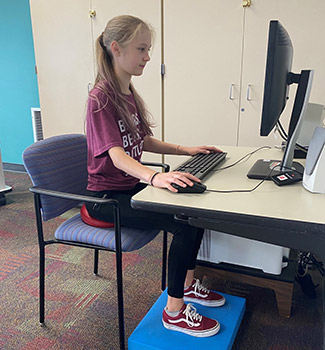Remote Learning Tips From Our Physical and Occupational Therapists
Ergonomics and Proper Body Positioning for Remote Learning
With our increasingly remote lives, it becomes necessary to emphasize ergonomics and proper body positioning while at home, and this is especially true with children. Prolonged hours in front of a computer screen can cause aches and pains in anybody, but children can be particularly susceptible to developing postural issues down the line if not educated on the importance of proper sitting ergonomics. The physical therapy and occupational therapy teams at the Portland Shriners Hospital collaborated to provide you with some tips and tricks to promote good habits and proper posture to make your child’s online learning experience is positive.
Proper desk set-up
- Adjust monitor or laptop screen:
- Utilize a laptop stand or a stack of books to raise the height of the screen to avoid neck strain.
- Position the screen directly in front of your child, keeping the screen at head or eye level and at least 20 inches away.
- Adjust chair:
- Make sure your child’s feet are flat on the floor and they are sitting upright.
- Ensure that they are able to sit and avoid slouching or bending forward.
- Check the position of the keyboard and mouse:
- Make sure your child’s wrists and elbows are properly supported.
- Consider using a wireless external keyboard and mouse if they use a laptop to help attain a better position.
Tips and tricks:
- Stand up and stretch every 20 – 45 minutes to take short breaks and allow your child to relax and avoid muscle strain.
- Ways to break up their study schedule:
- Take short breaks.
- Incorporate exercise.
- Get up and get a drink of water.
- Play with a pet or chat with family.
- Mix up your child’s school set-up by changing locations or encouraging them to use a therapy ball to sit on.
Body check (perform periodically throughout the day):
- Make sure your child’s shoulders are directly over and slightly in front of their hips.
- Have your child lift their arms out, overhead and back down to their side as if making an upright snow angel in order to assess and re-align their shoulders.
- Assure their feet are on the floor tucked under and slightly behind their knees.
- Take inventory of their head and neck. Ensure that their position prevents strain by looking 15 feet beyond their desk and then trying to maintain that position while focusing their eyes back to your device.
We hope these tips are useful! Learn more about the rehabilitation services offered at the Portland Shriners Hospital.

Keep In Touch
Join our mailing list to stay up to date on everything that's happening at Shriners Children's.
